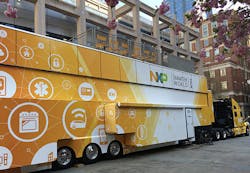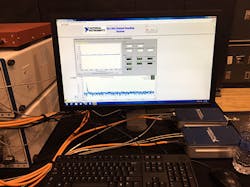A couple of weeks ago, I had the opportunity to attend the Brooklyn 5G Summit 2016 at NYU Tandon School of Engineering. The invitation-only summit was organized by NYU WIRELESS and Nokia. Global industry leaders in wireless, automotive, healthcare, academia, and government discussed and revealed the latest advancements toward making 5G a reality. Among notable announcements made during the summit:
* Researcher Theodore Rappaport announced that New York University is making its channel model simulator and measurement data free and open to all—potentially short-circuiting years of millimeter-wave (mm-wave) development time for companies hoping to vastly increase the transfer of data through the air. The simulation software allows researchers to understand the behavior and capabilities of the mm-wave radio spectrum.
* National Instruments (NI) announced a software-defined radio (SDR) for the mm-wave spectrum to help speed 5G research. The mmWave Transceiver System is a modular system with 2 GHz of real-time bandwidth covering spectrum in the E-band (71-76 GHz). It can be configured for single-input single-output (SISO) and multiple-input multiple-output (MIMO) (Fig. 1). Combined with LabVIEW software, this hardware can be reconfigured to service the continually growing demands of cutting-edge wireless research. The mmWave radio heads are also modular and can be replaced with other RF front ends to investigate multiple different frequencies with the same base set of hardware and software. This aspect promises to save engineering design time while providing maximum system reuse.
* Nokia revealed a high-data-rate mm-wave system that uses a phased array at 60 GHz. It relies on NI’s platform (Fig. 2).
* AT&T announced details about 5G tests, saying it will extend its current lab testing to an outdoor test in Austin, Texas. The company will mainly focus on fixed wireless. A15-GHz band will be used now, but it will move to 28 GHz when the equipment is available.
So much has been said about the multiple changes that 5G networks will bring to our society as well as the many businesses that will benefit from its implementation. One of them is the Internet of Things (IoT). 5G is expected to reduce network response times (latency) and therefore allow the high density of IoT devices and sensors to perform better in real time. NXP Semiconductors brought to Brooklyn its triple-decker truck (Fig. 3) containing more than 100 examples of the very latest Internet of Things prototypes and technologies. We took a tour of the bus and saw the latest demos in IoT devices applied across multiple technologies areas like home, medical, smart cities, etc. (If you want to see in more detail what is inside the NXP bus, please check out my latest gallery.)
Among the panelists during the three-day event were leaders from many diverse backgrounds and industry sectors from companies like Nokia, Verizon, DoCoMo, T-Mobile, Samsung, Huawei, T-Mobile, Vodafone, CableLabs, and National Instruments, as well as the Federal Communications Commission and National Science Foundation. During panel discussions, they covered a wide range of topics (among these, Progress in Channel Models and Spectrum 5G, New Wireless Business, and RAN for 5G).
2020 is the year when the first commercial 5G networks will be launched. Yet there are still many challenges to overcome before turning 5G into reality. I left the summit with these thoughts:
5G will certainly generate more jobs and help the economic growth of the United States. A report from Bell Labs Consulting estimates that by 2020, global demand for digital content and services on mobile and portable devices will increase an average of 30 to 40 times from 2014 levels.
Prototyping technologies will help 5G become a reality by validating assumptions before fabrication.
Minimal power consumption and low latency for real-time sensors will benefit the IoT market and machine-to-machine (M2M) communications.
Multiple integrated antennas could generate good signals, but might increase cost and power consumption. They still need to figure out a better way of integrating antennas in the phones and find a balance between good signal, cost, and power consumption.
The standardization process should be a collaborative effort with participation of all the players in the wireless industry (e.g., operators, vendors, telecommunication regulatory bodies, etc).
Sharing the spectrum will improve the efficiency of spectrum utilization, while avoiding fragmentation will be crucial to support a worldwide market.
Looking for parts? Go to SourceESB.
About the Author
Maria Guerra Blog
Power/Analog Editor
Maria Guerra is the Power/Analog Editor for Electronic Design. She is an Electrical Engineer with an MSEE from NYU Tandon School of Engineering. She has a very solid engineering background and extensive experience with technical documentation and writing. Before joining Electronic Design, she was an Electrical Engineer for Kellogg, Brown & Root Ltd (London. U.K.). During her years in the Oil and Gas Industry she was involved in a range of projects for both offshore and onshore designs. Her technical and soft skills bring a practical, hands-on approach to the Electronic Design team.



